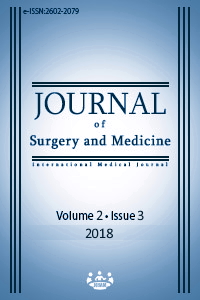Comparison of three different sternal closure techniques after cardiac surgery in elderly patients
Keywords:
Nitinol clips, Sternotomy, Sternal closure, Stainless steel wires, Robicsek techniqueAbstract
Aim: To identify the effectivity of stainless steel wires (SSW), Robicsek technique (RT) and thermoreactive nitinol clips (TNC) for sternal closure in elderly patients.
Methods: We conducted a prospective randomized study to compare SSW, RT and TNC in the sternal closure between January 2015 and January 2017. Patients over 60 years old who required sternal closure following cardiac surgery were enrolled into the study. Preoperative characteristics, operative parameters and EuroSCORE were recorded for each patient. In postoperative period, duration of intensive care unit stay and hospitalization, complications and mortality rates were analyzed. All patients evaluated according to the Visual analogue scale score (VAS) on 1st, 3rd and 5th day after the operation.
Results: 96 patients (32 patients with SSW, 32 patients with RT and 32 patients with TNC) required sternal closure. Patients in which sternal closure was performed with TNC, achieved significantly shorter hospitalization period (p=0.014) and no any dehiscence (p= 0.014). We achieved significantly better VAS scores in patients with TNC (p<0.001, p<0.001 and p<0.001, respectively). In multivariate regression analysis, superficial sternal wound infection (SSWI) and DSWI were the only predictive factors for sternal dehiscence (p=0.029 and p=0.015, respectively).
Conclusion: Our study showed that using TNC decreased the hospitalization duration, DSWI, sternal dehiscence development and postoperative pain intensity. SSWI and DSWI were found to be the only predictive factors for sternal dehiscence in multivariate regression analysis.
Downloads
References
Murray KD, Pasque MK. Routine sternal closure using six overlapping figure of 8 wires. Ann Thorac Surg. 1997;64:1852-4.
Plass A, Grünenfelder J, Reuthebuch O, Vachenauer R, Gauer JM, Zünd G, et al. New transverse plate fixation system for complicated sternal wound infection after median sternotomy. Ann Thorac Surg. 2007;83:1210-2.
Liu JY, Birkmeyer NJ, Sanders JH, et al. Risks of morbidity and mortality in dialysis patients undergoing coronary artery bypass surgery. Northern New England Cardiovascular Disease Study Group. Circulation. 2000;102:2973–7.
Levin LS, Miller AS, Gajjar AH, Bremer KD, Spann J, Milano CA, et al. An innovative approach for sternal closure. Ann Thorac Surg. 2010;89:1995-9.
Negri A, Manfredi J, Terrini A, Rodella G, Bisleri G, El Quarra S, et al. Prospective evaluation of a new sternal closure method with thermoreactive clips. Eur J Cardiothorac Surg. 2002;22:571-5.
Sharma R, Puri D, Panigrahi BP, Virdi IS. A modified parasternal wire technique for prevention and treatment of sternal dehiscence. Ann Thorac Surg. 2004;77:210-3.
Robicsek F, Daugherty HK, Cook JW. The prevention and treatment of sternum separation following open-heart surgery. J Thorac Cardiovasc Surg. 1977;73:267-8.
Sarıkaya S, Büyükbayrak F, Altaş Ö, Yerlikhan O, Fedakar A, Rabuş M, Kırali K. Thermoreactive nitinol clips for re-sternotomy in cases of sternal dehiscence. Türk Göğüs Kalp Damar Cerrahisi Dergisi. 2013;21:669-75.
Roques F, Nashef SA, Michel P, Gauducheau E, De Vincentiis C, Baudet E, Cortina J, David M, Faichney A, Gavrielle F, Gams E. Risk factors and outcome in European cardiac surgery: analysis of the EuroSCORE multinational database of 19030 patients. European Journal of Cardio-thoracic Surgery. 1999;15:816-23.
Collins SL, Moore RA, McQuay HJ. The visual analogue pain intensity scale: what is moderate pain in millimetres? Pain. 1997;72:95-7.
Freund AM, Smith J. Self-definition in old age. Zeitschrift fur Sozialpsychologieç 1997;28:44-59.
McCarthy JP, Skinner TA, Norman RW. Urolithiasis in the elderly. Can J Urologyç 2011;18:5717–20.
Dunne B, Murphy M, Skiba R, Wang X, Ho K, Larbalestier R, Merry C. Sternal cables are not superior to traditional sternal wiring for preventing deep sternal wound infection. Interact Cardiovasc Thorac Surg. 2016 May;22(5):594-8.
Sarıkaya S, Aksoy E, Özen Y, Dedemoğlu M, Özgür MM, Büyükbayrak F, Kırali K. Thermoreactive nitinol clips: propensity score comparison with Robicsek technique. Asian Cardiovascular and Thoracic Annals. 2015;23:399-405.
Bejko J, Bottio T, Tarzia V, De Franceschi M, Bianco R, Gallo M, Castoro M, Bortolussi G, Gerosa G. Nitinol flexigrip sternal closure system and standard sternal steel wiring: insight from a matched comparative analysis. Journal of Cardiovascular Medicine. 2015;16:134-8.
Cotogni P, Barbero C, Rinaldi M. Deep sternal wound infection after cardiac surgery: evidences and controversies. World Journal of Critical Care Medicine. 2015;4:265-72.
El Oakley RM, Wright JE. Postoperative mediastinitis: classification and management. Ann Thorac Surg. 1996;61:1030–6.
Nikolaidis N, Karangelis D, Mattam K, Tsang G, Ohri S. The use of Nitinol clips for primary sternal closure in cardiac surgery. Annals of Thoracic and Cardiovascular Surgery. 2013;19:330-4.
Borger MA, Rao V, Weisel RD, Ivanov J, Cohen G, Scully HE, David TE. Deep sternal wound infection: risk factors and outcomes. The Annals of Thoracic Surgery. 1998;65:1050-6.
Bejko J, Tarzia V, De Franceschi M, Bianco R, Castoro M, Bottio T, Gerosa G. Nitinol flexigrip sternal closure system and chest wound infections: insight from a comparative analysis of complications and costs. The Annals of Thoracic Surgery. 2012;94:1848-53.
Hashim S, Chin LY, Krishnasamy S, Sthaneswar P, Mokhtar RA. Effect of sternal closure with biological bone adhesive on pain visual analogue score and serum cytokine. Journal of Cardiothoracic Surgery. 2015;10:32-8.
Elghonemy YF, Hussein MA. Titanium plate fixation versus wire sternal closure in coronary artery bypass graft patients: Need for rigid sternal fixation. Journal of the Egyptian Society of Cardio-Thoracic Surgery. 2016;24:150-8.
Downloads
- 10383 2506
Published
Issue
Section
How to Cite
License
Copyright (c) 2018 Mazlum Şahin, Helin El, Fatma Tuba İlal Mert
This work is licensed under a Creative Commons Attribution-NonCommercial-NoDerivatives 4.0 International License.















